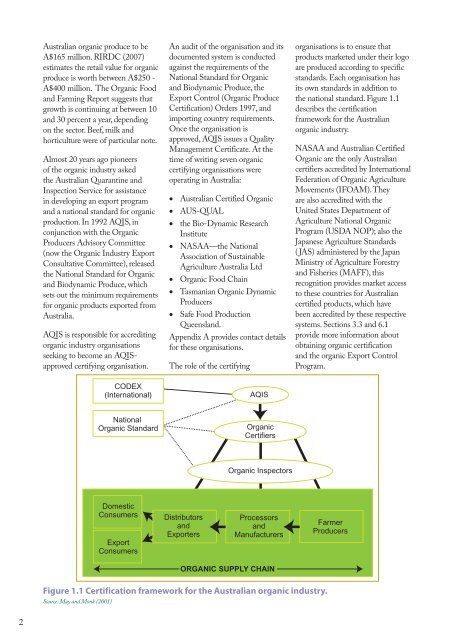4. Organic vegetable production
4. Organic vegetable production
4. Organic vegetable production
Create successful ePaper yourself
Turn your PDF publications into a flip-book with our unique Google optimized e-Paper software.
Australian organic produce to be<br />
A$165 million. RIRDC (2007)<br />
estimates the retail value for organic<br />
produce is worth between A$250 -<br />
A$400 million. The <strong>Organic</strong> Food<br />
and Farming Report suggests that<br />
growth is continuing at between 10<br />
and 30 percent a year, depending<br />
on the sector. Beef, milk and<br />
horticulture were of particular note.<br />
Almost 20 years ago pioneers<br />
of the organic industry asked<br />
the Australian Quarantine and<br />
Inspection Service for assistance<br />
in developing an export program<br />
and a national standard for organic<br />
<strong>production</strong>. In 1992 AQIS, in<br />
conjunction with the <strong>Organic</strong><br />
Producers Advisory Committee<br />
(now the <strong>Organic</strong> Industry Export<br />
Consultative Committee), released<br />
the National Standard for <strong>Organic</strong><br />
and Biodynamic Produce, which<br />
sets out the minimum requirements<br />
for organic products exported from<br />
Australia.<br />
AQIS is responsible for accrediting<br />
organic industry organisations<br />
seeking to become an AQISapproved<br />
certifying organisation.<br />
An audit of the organisation and its<br />
documented system is conducted<br />
against the requirements of the<br />
National Standard for <strong>Organic</strong><br />
and Biodynamic Produce, the<br />
Export Control (<strong>Organic</strong> Produce<br />
Certification) Orders 1997, and<br />
importing country requirements.<br />
Once the organisation is<br />
approved, AQIS issues a Quality<br />
Management Certificate. At the<br />
time of writing seven organic<br />
certifying organisations were<br />
operating in Australia:<br />
• Australian Certified <strong>Organic</strong><br />
• AUS-QUAL<br />
• the Bio-Dynamic Research<br />
Institute<br />
• NASAA—the National<br />
Association of Sustainable<br />
Agriculture Australia Ltd<br />
• <strong>Organic</strong> Food Chain<br />
• Tasmanian <strong>Organic</strong> Dynamic<br />
Producers<br />
• Safe Food Production<br />
Queensland.<br />
Appendix A provides contact details<br />
for these organisations.<br />
The role of the certifying<br />
organisations is to ensure that<br />
products marketed under their logo<br />
are produced according to specific<br />
standards. Each organisation has<br />
its own standards in addition to<br />
the national standard. Figure 1.1<br />
describes the certification<br />
framework for the Australian<br />
organic industry.<br />
NASAA and Australian Certified<br />
<strong>Organic</strong> are the only Australian<br />
certifiers accredited by International<br />
Federation of <strong>Organic</strong> Agriculture<br />
Movements (IFOAM). They<br />
are also accredited with the<br />
United States Department of<br />
Agriculture National <strong>Organic</strong><br />
Program (USDA NOP); also the<br />
Japanese Agriculture Standards<br />
(JAS) administered by the Japan<br />
Ministry of Agriculture Forestry<br />
and Fisheries (MAFF), this<br />
recognition provides market access<br />
to these countries for Australian<br />
certified products, which have<br />
been accredited by these respective<br />
systems. Sections 3.3 and 6.1<br />
provide more information about<br />
obtaining organic certification<br />
and the organic Export Control<br />
Program.<br />
CODEX<br />
(International)<br />
AQIS<br />
National<br />
<strong>Organic</strong> Standard<br />
<strong>Organic</strong><br />
Certifiers<br />
<strong>Organic</strong> Inspectors<br />
Domestic<br />
Consumers<br />
Export<br />
Consumers<br />
Distributors<br />
and<br />
Exporters<br />
Processors<br />
and<br />
Manufacturers<br />
Farmer<br />
Producers<br />
ORGANIC SUPPLY CHAIN<br />
Figure 1.1 Certification framework for the Australian organic industry.<br />
Source: May and Monk (2001)

















